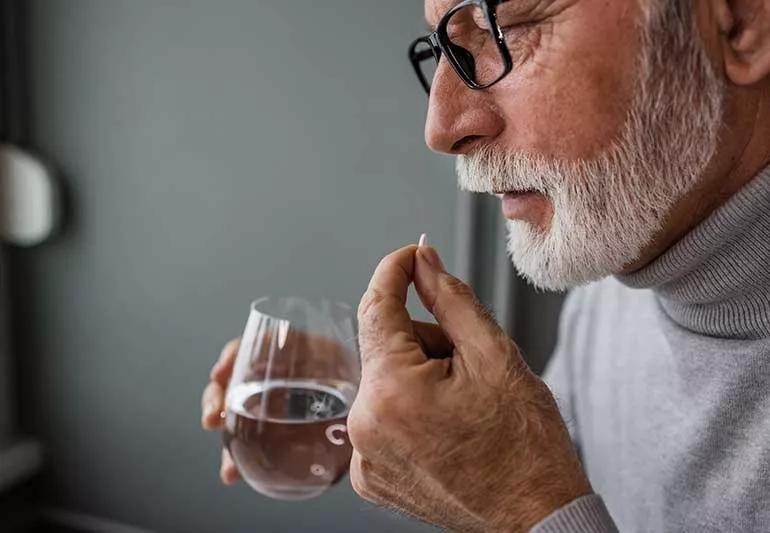Treating COVID-19 with Paxlovid may create a bitter taste, but it won’t last forever

It’s not unusual for medicine to taste bad. Memorably, Mary Poppins even suggested a spoonful of sugar to help the medicine go down. But Paxlovid™, a medication used to treat COVID-19 in some adults and children over age 12, takes the idea of bad-tasting medicine to another level.
Advertisement
Cleveland Clinic is a non-profit academic medical center. Advertising on our site helps support our mission. We do not endorse non-Cleveland Clinic products or services. Policy
It’s not that Paxlovid itself tastes terrible. But in some people, a side effect of Paxlovid is an unpleasant and lingering taste that develops in your mouth a day or two after beginning the medicine.
“We know that COVID-19 can cause taste disturbances or loss of taste,” says clinical pharmacy specialist Andrea Pallotta, PharmD, BCIDP, “but this side effect of Paxlovid, called ‘Paxlovid mouth,’ isn’t the same thing.”
Infectious disease specialist Tricia Bravo, MD, adds that despite this unpleasant side effect, Paxlovid is an effective treatment against COVID-19. “Every medication has its risks and benefits,” she notes.
The altered sense of taste, called dysgeusia, is harmless and temporary, but it can make you miserable — especially on top of your COVID-19 symptoms. Dr. Bravo and Pallotta share what you need to know about Paxlovid mouth and offer helpful hints to make it bearable.
Paxlovid is currently the preferred treatment for mild to moderate COVID-19 in people who are at high risk for developing a severe case of the disease and who are within five days of first showing symptoms. It’s a combination of two medications:
Advertisement
The U.S. Food and Drug Administration (FDA) granted Paxlovid emergency use approval in 2021 to treat COVID-19 in high-risk adults and children over 12. In May 2023, it was approved by the FDA as the first oral antiviral for to treat mild to moderate COVID-19 in adults, while retaining its emergency use authorization status for children 12 to 18 years of age. A standard course of therapy includes three tablets (two nirmatrelvir and one ritonavir) taken twice daily for five days.
“Paxlovid is still active against current variants of COVID-19,” Dr. Bravo says. “If a high-risk individual has mild to moderate symptoms and they don’t have contraindications from taking the drug, this is our first-line oral antiviral.”
“Paxlovid mouth” refers to the altered taste some people get while taking the medication. But not everyone experiences dysgeusia when they take Paxlovid. In clinical trials, about 6% of people experienced it.
Most people describe the lingering taste as metallic or bitter, and the intensity of the flavor can vary from person to person. You may get a break from the terrible taste when you eat or drink, or you may find that food and beverages take on the metallic taste.
There’s no conclusive evidence explaining why Paxlovid causes an altered sense of taste, but experts suspect that ritonavir is the culprit. The FDA initially approved ritonavir for treating HIV and reported that more than 16% of people experienced dysgeusia during clinical trials.
Still, they haven’t been able to pinpoint why some medications cause dysgeusia. One theory is that ritonavir triggers the taste buds associated with bitter taste.
“The cause of Paxlovid mouth could be medication-induced changes to the saliva, changes in how your saliva flows or stimulation of specific taste bud receptors,” Pallotta says. “But right now, it’s all theoretical. No one knows for sure.”
The dysgeusia you can get with Paxlovid is typically mild and not dangerous to your health — unless you stop taking Paxlovid because of it.
“When we prescribe Paxlovid, we discuss the risks and benefits with you,” Dr. Bravo explains. “Taking Paxlovid helps you avoid a more severe COVID-19 infection that could result in hospitalization or death. So that greatly outweighs a taste disturbance that is mild and temporary.”
Otherwise, Pallotta says, the only other way Paxlovid mouth can cause harm to your health is if you stop eating or drinking and get dehydrated. Lowering your fluid intake because of the taste becomes even more dangerous if you have other side effects of Paxlovid, which include:
“People taking Paxlovid are already dealing with COVID-19 symptoms and may have other dehydrating conditions as a side effect of Paxlovid,” she adds. “They need to find ways to get plenty of fluids and stay hydrated.”
Advertisement
Dysgeusia doesn’t last forever and typically disappears shortly after you finish the medication.
“Some reports show dysgeusia related to Paxlovid lasting as long as 34 days, but more commonly, it goes away a few days after you stop the medication,” Dr. Bravo says. “It probably has to do with when your body gets the medication out of its system.”
In the meantime, there are some things you can do to deal with the unpleasant taste.
While there’s no tried-and-true way to stop or prevent Paxlovid mouth, Pallotta says there are remedies you can try:
Advertisement
Paxlovid mouth is temporary and relatively harmless, but it can still affect you. Don’t hesitate to call your healthcare provider if the taste is too much to handle or if it affects your diet, like if you’re not eating and drinking as a result.
“If you’re having trouble keeping food down or staying hydrated, don’t just try to ride it out,” Dr. Bravo advises. “Your provider prescribed Paxlovid to help prevent a more severe case of COVID-19, but it’s also important to keep you nourished while you’re sick.”
Advertisement
Learn more about our editorial process.
Advertisement

Most can return to work or school when they’re symptom-free for 24 hours

Covering your mouth when you cough and staying home when you’re sick are a couple ways to help keep yourself and others COVID-free

This vital nutrient supports your health, but its role in COVID-19 prevention and treatment isn’t proven

Studies have shown promising results, but additional research is needed

Infection and inflammation can cause you to lose your voice and have other voice changes until you’re fully healed

A COVID-19 infection can bring on depression or anxiety months after physical symptoms go away

Just like the flu, COVID-19 continues to evolve every year with new and smarter variants

The latest omicron subvariants carry specific mutations that may allow the SARS-CoV-2 virus to be better at evading immune protection

Babies can get congested easily, but you can calm their cough by keeping them hydrated, using nasal drops and running a humidifier

Weight loss may cause loose, sagging skin and muscle loss to your rear

Several conditions, like vitiligo and fungal infection, can cause a loss of pigmentation, leading to white spots or patches on your skin